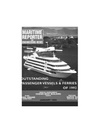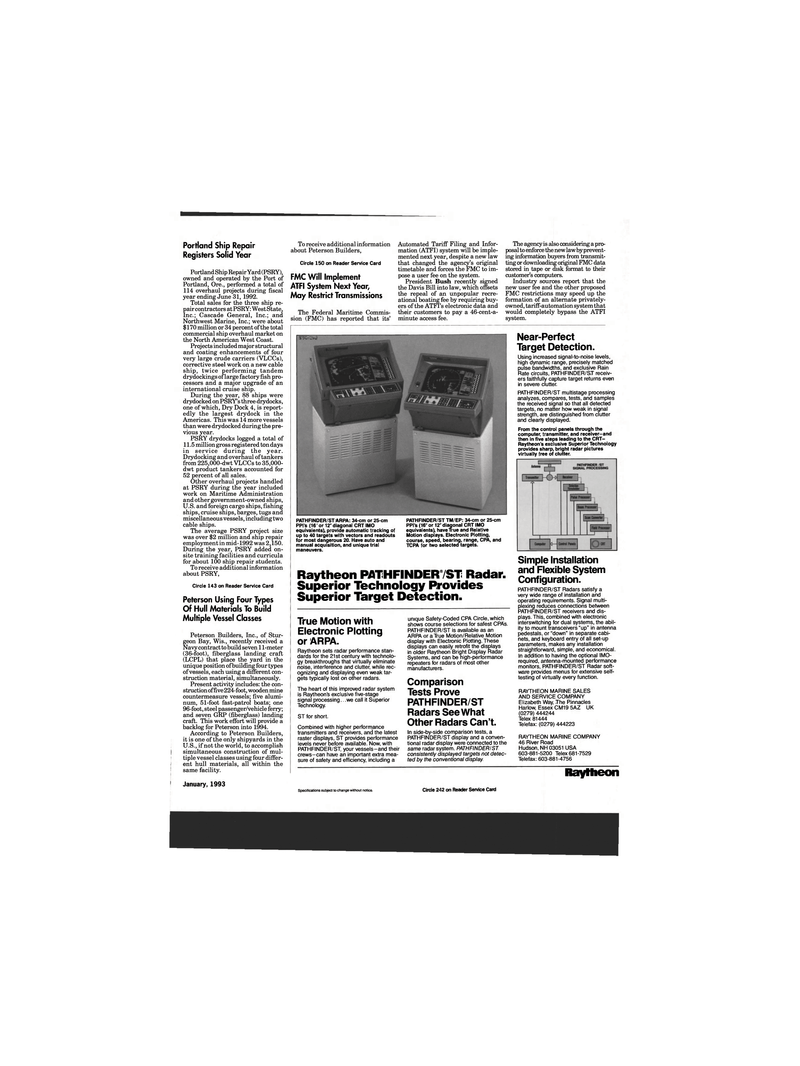
Page 11: of Maritime Reporter Magazine (January 1993)
Read this page in Pdf, Flash or Html5 edition of January 1993 Maritime Reporter Magazine
Automated Tariff Filing and Infor- mation (ATFI) system will be imple- mented next year, despite a new law that changed the agency's original timetable and forces the FMC to im- pose a user fee on the system.
President Bush recently signed the Davis Bill into law, which offsets the repeal of an unpopular recre- ational boating fee by requiring buy- ers of the ATFI's electronic data and their customers to pay a 46-cent-a- minute access fee.
The agency is also considering a pro- posal to enforce the new law by prevent- ing information buyers from transmit- ting or downloading original FMC data stored in tape or disk format to their customer's computers.
Industry sources report that the new user fee and the other proposed
FMC restrictions may speed up the formation of an alternate privately- owned, tariff-automation system that would completely bypass the ATFI system.
Portland Ship Repair
Registers Solid Year
Portland Ship Repair Yard (PSRY), owned and operated by the Port of
Portland, Ore., performed a total of 114 overhaul projects during fiscal year ending June 31, 1992.
Total sales for the three ship re- pair contractors at PSRY: West State,
Inc.; Cascade General, Inc.; and
Northwest Marine, Inc.; were about $170 million or 34 percent of the total commercial ship overhaul market on the North American West Coast.
Projects included major structural and coating enhancements of four very large crude carriers (VLCCs), corrective steel work on a new cable ship, twice performing tandem drydockings of large factory fish pro- cessors and a major upgrade of an international cruise ship.
During the year, 88 ships were drydocked on PSRYs three drydocks, one of which, Dry Dock 4, is report- edly the largest drydock in the
Americas. This was 14 more vessels than were drydocked during the pre- vious year.
PSRY drydocks logged a total of 11.5 million gross registered ton days in service during the year.
Drydocking and overhaul of tankers from 225,000-dwt VLCCs to 35,000- dwt product tankers accounted for 52 percent of all sales.
Other overhaul projects handled at PSRY during the year included work on Maritime Administration and other government-owned ships,
U.S. and foreign cargo ships, fishing ships, cruise ships, barges, tugs and miscellaneous vessels, includingtwo cable ships.
The average PSRY project size was over $2 million and ship repair employment in mid-1992 was 2,150.
During the year, PSRY added on- site training facilities and curricula for about 100 ship repair students.
To receive additional information about PSRY,
Circle 143 on Reader Service Card
Peterson Using Four Types
Of Hull Materials To Build
Multiple Vessel Classes
Peterson Builders, Inc., of Stur- geon Bay, Wis., recently received a
Navy contract to build seven 11 -meter (36-foot), fiberglass landing craft (LCPL) that place the yard in the unique position of building four types of vessels, each using a different con- struction material, simultaneously.
Present activity includes: the con- struction of five 224-foot, wooden mine countermeasure vessels; five alumi- num, 51-foot fast-patrol boats; one 96-foot, steel passenger/vehicle ferry; and seven GRP (fiberglass) landing craft. This work effort will provide a backlog for Peterson into 1994.
According to Peterson Builders, it is one of the only shipyards in the
U.S., if not the world, to accomplish simultaneous construction of mul- tiple vessel classes using four differ- ent hull materials, all within the same facility.
January, 1993 13
To receive additional information about Peterson Builders,
Circle 150 on Reader Service Card
FMC Will Implement
ATFI System Next Year,
May Restrict Transmissions
The Federal Maritime Commis- sion (FMC) has reported that its'
PATHFINDER/ST ARPA: 34-cm or 25-cm
PPI's (16"or 12"diagonal CRTIMO equivalents), provide automatic tracking of up to 40 targets with vectors and readouts for most dangerous 20. Have auto and manual acquisition, and unique trial maneuvers.
True Motion with
Electronic Plotting or ARPA.
Raytheon sets radar performance stan- dards for the 21st century with technolo- gy breakthroughs that virtually eliminate noise, interference and clutter, while rec- ognizing and displaying even weak tar- gets typically lost on other radars.
The heart of this improved radar system is Raytheon's exclusive five-stage signal processing.. .we call it Superior
Technology.
ST for short.
Combined with higher performance transmitters and receivers, and the latest raster displays, ST provides performance levels never before available. Now, with
PATHFINDER/ST, your vessels-and their crews-can have an important extra mea- sure of safety and efficiency, including a
Specifications subject to change without notice.
PATHFINDER/ST TM/EP: 34-cm or 25-cm
PPI's (16" or 12" diagonal CRT IMO equivalents), have True and Relative
Motion displays. Electronic Plotting, course, speed, bearing, range, CPA, and
TCPA for two selectedtargets. unique Safety-Coded CPA Circle, which shows course selections for safest CPAs.
PATHFINDER/ST is available as an
ARPA or a True Motion/Relative Motion display with Electronic Plotting. These displays can easily retrofit the displays in older Raytheon Bright Display Radar
Systems, and can be high-performance repeaters for radars of most other manufacturers.
Comparison
Tests Prove
PATHFINDER/ST
Radars See What
Other Radars Can't.
In side-by-side comparison tests, a
PATHFINDER/ST display and a conven- tional radar display were connected to the same radar system. PATHFINDER/ST consistently displayed targets not detec- ted by the conventional display.
Circle 242 on Reader Service Card
Near-Perfect
Target Detection.
Using increased signal-to-noise levels, high dynamic range, precisely matched pulse bandwidths, and exclusive Rain
Rate circuits, PATHFINDER/ST receiv- ers faithfully capture target returns even in severe clutter.
PATHFINDER/ST multistage processing analyzes, compares, tests, and samples the received signal so that all detected targets, no matter how weak in signal strength, are distinguished from clutter and clearly displayed.
From the control panels through the computer, transmitter, and receiver-and then in five steps leading to the CRT-
Raytheon's exclusive Superior Technology provides sharp, bright radar pictures virtually free of clutter.
Simple Installation and Flexible System
Configuration.
PATHFINDER/ST Radars satisfy a very wide range of installation and operating requirements. Signal multi- plexing reduces connections between
PATHFINDER/ST receivers and dis- plays. This, combined with electronic interswitching for dual systems, the abil- ity to mount transceivers "up" in antenna pedestals, or "down" in separate cabi- nets, and keyboard entry of all set-up parameters, makes any installation straightforward, simple, and economical.
In addition to having the optional IMO- required, antenna-mounted performance monitors, PATHFINDER/ST Radar soft- ware provides menus for extensive self- testing of virtually every function.
RAYTHEON MARINE SALES
AND SERVICE COMPANY
Elizabeth Way, The Pinnacles
Harlow, Essex CM19 5AZ UK (0279) 444244
Telex 81444
Telefax: (0279) 444223
RAYTHEON MARINE COMPANY 46 River Road
Hudson, NH 03051 USA 603-881-5200 Telex 681-7529
Telefax: 603-881-4756
Raytheon
Raytheon PATHFINDER /ST Radar. Superior Technology Provides
Superior Target Detection.
WSmSmI / •

 10
10

 12
12
